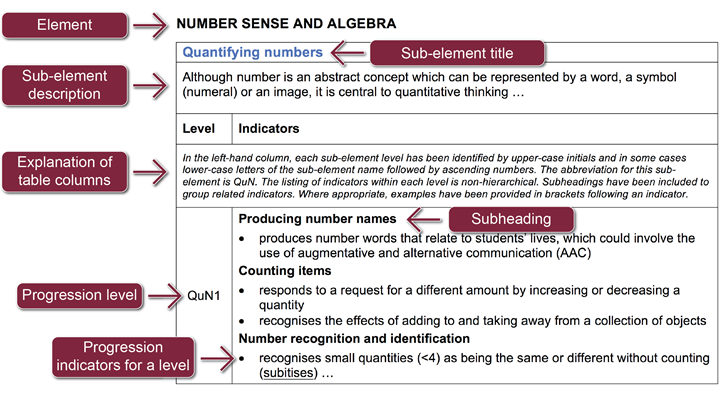Elements and sub-elements
The National Numeracy Learning Progression has three elements that reflect aspects of numeracy development necessary for successful learners of the F–10 Australian Curriculum and in everyday life. The three elements are:
- Number sense and algebra
- Measurement and geometry
- Statistics and probability.
Each of the elements includes sub-elements that present developmental sequences for important aspects of numeracy capability. There are nine sub-elements in Number sense and algebra, four in Measurement and geometry and two in Statistics and probability.
The diagram (Figure 1) represents the elements and sub-elements in relation to the numeracy development of the student.

Figure 1. Elements and sub-elements of the National Numeracy Learning Progression
Levels and indicators
Within each sub-element indicators are grouped together to form developmental levels. Each indicator describes what a student says, does or produces and begins with the implicit stem ‘A student …’ as the subject of the sentence.
There are as many levels within each sub-element as can be supported by evidence. The listing of indicators within a level is non-hierarchical as the levels are collections of indicators. Each level within a sub-element has one or more indicators and is more sophisticated or complex than the preceding level.
In many of the sub-elements, subheadings have been included to assist teachers by grouping indicators into particular categories of skills that develop over a number of levels.
The amount of time it takes students to progress through each level is not specified since students progress in numeracy development at different rates.
The levels do not describe equal intervals of time in students’ learning. They are designed to indicate the order in which students acquire the knowledge and skills necessary to be numerate. As learning is very rapid in the early years of school, the initial levels tend to be more detailed than the later levels.
Moreover, the amount of detail in any level or sub-element is not an indication of importance. A single indicator at a higher level in the progression may rely on a substantial number of indicators being evident in earlier levels. The diagram (Figure 2) shows the various components included in the progression

Figure 2. Annotated example of a numeracy sub-element